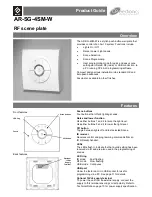
User Manual
551
Rev. 1.1
2019-03-18
TLE984xQX
Microcontroller with LIN and Power Switches for Automotive Applications
Capture/Compare Unit 6 (CCU6)
18.6
Multi-Channel Mode
The Multi-Channel mode offers the possibility to modulate all six T12-related output signals with one
instruction. The bits in bit field MCMOUT.MCMP are used to specify the outputs that may become active. If
Multi-Channel mode is enabled (bit MODCTR.MCMEN = 1), only those outputs may become active, that have a
1 at the corresponding bit position in bit field MCMP.
This bit field has its own shadow bit field MCMOUTS.MCMPS, that can be written by software. The transfer of
the new value in MCMPS to the bit field MCMP can be triggered by, and synchronized to, T12 or T13 events. This
structure permits the software to write the new value, that is then taken into account by the hardware at a
well-defined moment and synchronized to a PWM signal. This avoids unintended pulses due to
unsynchronized modulation sources.
Figure 153 Multi-Channel Mode Block Diagram
shows the functional blocks for the Multi-Channel operation, controlled by bit fields in register
MCMCTR. The event that triggers the update of bit field MCMP is chosen by SWSEL. In order to synchronize the
update of MCMP to a PWM generated by T12 or T13, bit field SWSYN allows the selection of the synchronization
event leading to the transfer from MCMPS to MCMP. Due to this structure, an update takes place with a new
PWM period. A reminder flag R is set when the selected switching event occurs (the event is not necessarily
synchronous to the modulating PWM), and is cleared when the transfer takes place. This flag can be monitored
by software to check for the status of this logic block. If the shadow transfer from MCMPS to MCMP takes place,
bit IS.STR becomes set and an interrupt can be generated.
In addition to the Multi-Channel shadow transfer event MCM_ST, the shadow transfers for T12 (T12_ST) and
T13 (T13_ST) can be generated to allow concurrent updates of applied duty cycles for T12 and/or T13
modulation and Multi-Channel patterns.
If it is explicitly desired, the update takes place immediately with the occurrence of the selected event when
the direct synchronization mode is selected. The update can also be requested by software by writing to bit
CCU6_M
Switching
Synchro-
nization
Shadow Register
MCMOUTS.MCMPS
Shadow Transfer
MCM_ST
Register
MCMOUT.MCMP
T12 Output Modulation
Outputs CC6x/COUT6x
T12_ZM
T13_ZM
T12_PM
CM_61
T12_OM
T13_PM
CM_CHE
SWSEL
CDIR
SWSYN
STRMCM
Switching
Event
Detection
R
set
clear
STR
set
To Interrupt Control
clear
IDLE
T12/T13
Shadow
Transfer
Control
T13_ST
T12_ST
STE12U
STE12D
STE13U
















































